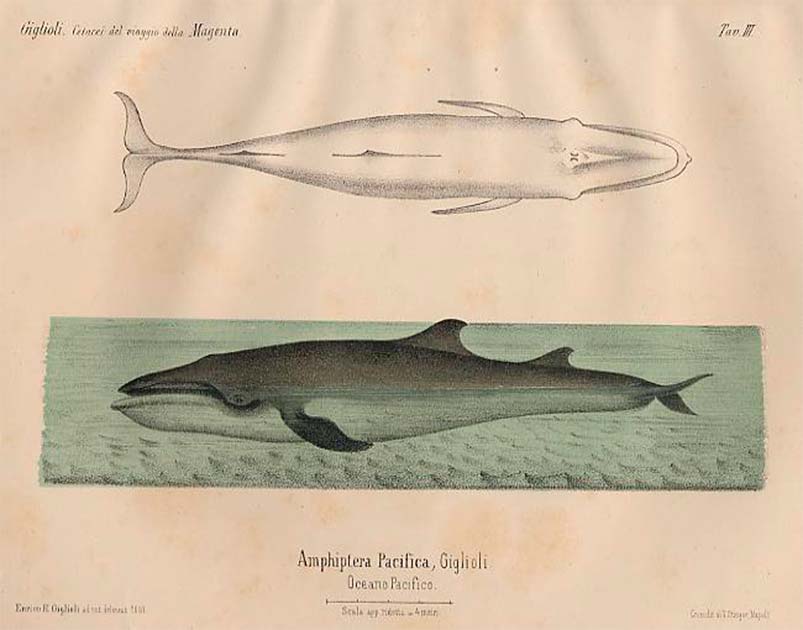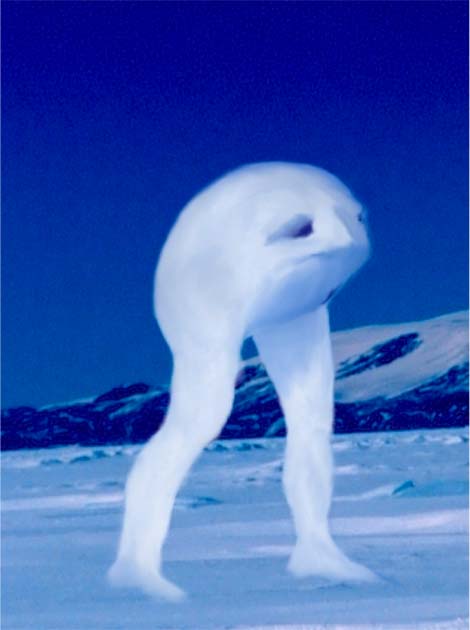Whales are the largest animals to have ever lived. And while many species of these gentle monsters of the deep are well known, the ocean is a big place and other species are still being discovered.
Amongst the scientifically confirmed sightings however there are other witness reports, or whales which defy current taxonomy. While many of these stories are dismissed as myth or legend, there are some tales that persist, sparking the imagination of scientists and enthusiasts alike.
These so called “cryptid whales” are a rumor which refuses to die, with reports of strange and elusive creatures lurking in the depths of the ocean. While evidence of these creatures remains scarce, the idea of undiscovered species of giant marine mammals continues to captivate the imagination of those who are drawn to the mysteries of the deep.
The list of cryptid whales is a long one, but these are some of the most famous examples.
Giglioli’s Whale
Also known as Amphiptera Pacifica, reports of this specific cryptid date back as far as the 19th century. The first of these comes on September 4, 1867, when the Italian zoologist Enrico Hillyer Giglioli was on a sailing trip.
This was no jaunt around the Med, however: this was the open ocean of the Pacific. And this was where, 1,930 kilometers (1,200 miles) off the coast of Chile aboard the Magenta, that he spotted something strange.

Swimming remarkably close to the ship was a whale with two distinct dorsal fins. This was strange because all whales only have one dorsal fin: it is a defining characteristic. Giglioli watched the whale for around 15 minutes, during which he took detailed notes.
His whale, he estimated, was 18 meters (59 ft) long and had an elongated body with 2 dorsal fins around 2 meters (6.6 ft) apart. He recorded that the whale closely resembles a rorqual (the same family as the blue whale) but with some added features. Besides the extra dorsal fin, it had sickle-shaped flippers and no throat pleats (folds of skin and blubber on the throat that expand when the whale is feeding to allow for extra space).
The following year the crew of another ship, the Lily, reported spotting a similar whale just off the coast of Scotland. Then, over 100 years later in 1983 another zoologist, Jacques Maigret, reported seeing another whale with two dorsal fins somewhere between Corsica and France.
Giglioli strongly believed he had discovered a new species of whale and gave it a classification. Modern zoologists are less convinced. It’s believed these whales were more than likely just genetic mutations.
- A Real-Life Moby Dick? The Wreck of the Essex
- The Megalodon: Could a Giant Shark be Hiding in our Oceans?
The reasoning behind this thinking is rather macabre. Simply put, if such a large and distinctive species actually existed, modern commercial whalers would have killed one by now.
Rhinoceros Dolphin
What’s better than a whale with two dorsal fins? A dolphin with two dorsal fins. The “rhinoceros dolphin”, also known as the delphinus rhinoceros or Cetodipteros rhinoceros is so called because it has a second dorsal fin near its head while its main dorsal fin is much further back than on a “normal” dolphin.

This cryptid was supposedly discovered by Jean René Constant Quoy and Joseph Gaimard, both zoologists, near New South Wales in Australia in the 19th century. They reported seeing a whole pod of dolphins that not only had an extra dorsal fin on their head but with dorsal fins that were larger than normal. These dolphins were also reportedly covered in “splotches.”
Once again, zoologists aren’t convinced. Various explanations have been given for the dolphins’ appearance. Some suggest that the two men were mistaken and that what they saw was either an optical illusion as the dolphins jumped out of the water, or they saw a dolphin with a remora (a type of fish) stuck on its head.
The problem with these explanations is they might explain seeing one “two finned” dolphin, but a whole pod? It seems a little unlikely a whole pod would be swimming round with remora stuck on their heads.
A more likely explanation is that, again, these extra dorsal fins were the result of a genetic mutation. Dorsal fin mutations in dolphins aren’t uncommon, even if another instance of this exact mutation has never been reported. Since more than one dolphin with these unique features was spotted at once, it’s been hypothesized that the pair were watching an inbred population, which led to them all having a similar mutation.
The High-finned Sperm Whale
Our next entry doesn’t have such an exciting name. The high-finned sperm whale or the high-finned cachalois is believed to be a north Atlantic variant of the sperm whale that happens to have a particularly tall dorsal fin. It was first spotted in 1687 by the physician Sir Robert Sibbald who claimed to have come across a stranded female on Orkney.
He described the dorsal fin as being similar in size to a mizzen mast (a ship’s third mast). This would mean the dorsal fin could have been as short as 20 feet (6 meters) to as tall as 80 feet (24 meters). Contemporary naturalists like Georges Cuvier discounted Sibbald’s claims, simply putting his account down to a bad description.
The cryptid was once again spotted on September 27, 1946, near Nova Scotia, Canada. This sighting was even less convincing. Locals said the creature was trapped in the area for two days and that its dorsal fin was between 3 and 30 meters (10 and 100 feet) long, which is more than a little vague.
The Alula Whale
The Alula whale, also known as the Alula killer or Orcinus mörzer-bruynsus, was first described and depicted by the zoologist W.F.J. Mörzer Bruyns in his Field Guide of Whales and Dolphins. He didn’t formally name the species but claimed to have personally witnessed the creature several times.
According to Bruyns, the Alula whale has a distinct appearance, resembling a sepia brown killer whale with a well-rounded forehead and white star-shaped scars on its body. Bruyns noted that they inhabit deep coastal waters from the eastern Gulf of Aden to Socotra and are typically spotted between April and September.
- U-Boat 85 and the Sea Monster: Terror from the Deep
- A Mighty Bang: Are We In Danger From Exploding Whales?
He estimated their size to be around 6-7 meters (20-23 feet) long, weighing 1.8 metric tonnes (2 tons) with a dorsal fin reaching up to 2 meters (7 feet) high. According to Bruyns, they typically travel in groups of 4-8 individuals, maintaining a cruising speed of 4 knots.

The strangest thing about this cryptid is perhaps that despite all the details given, Bruyns never formally named the species. It’s certainly less strange than the other entries here. Experts believe that rather than being a distinct species, the whales Bruyns recorded were likely a color variant or mutation of an existing species of killer whale.
Ningen
We finish our list with the most recent, and fantastical, example of a cryptid whale, the Ningen. Reports of this strange creature began surfacing in the early 2000s and it’s said to be an anatomical mixture of a whale and a human.
The Ningen supposedly has a human-like face and extremely long limbs that resemble arms and hands. It’s said to be a pale blue color with a large, slit-like mouth with either very small or large gaping eyes.

The first reports of the Ningen originated on a Japanese forum where a user claimed a whale research ship had spotted the creature surfacing off the Antarctic coast. Supposedly they thought it was a submarine but under closer investigation could find no traces of it.
Other internet users jumped on the bandwagon and there were several more “sightings.” In 2005 it was claimed Google Earth captured a shot of a Ningen near the Southern Ocean, although sceptics think this “Ningen” was actually either a small iceberg or wave formation.
Then, in 2010 a video went up on YouTube which ended with a shot of what many fans believe to be a Ningen. Others believe however that it was actually a snaggle-toothed snake eel or hoax.
Most likely the Ningen is a complete hoax and an example of modern internet folklore or urban legends, similar to the story of the Slenderman. A case of internet users telling each other exciting stories which are then misconstrued as fact.
Nothing more than a Series of Mistakes?
Cryptids pose an interesting problem for zoologists and scientists. They’re widely derided and looked down upon, until they’re proven to exist. And it does happen. Over the years various species, from mountain gorillas to the platypus have gone from cryptid to fact.
So, while some of these cryptid whales may seem unlikely, or easy to dismiss, it’s important to keep an open mind. For centuries, the giant squid was believed to be nothing more than a legend, until one washed up. The ocean is deep and dark and largely unexplored. Who knows what’s hiding in its ink waters?
Top Image: Could some of the “cryptid whales” spotted over the years be real, unknown species? Source: Georgy / Adobe Stock.